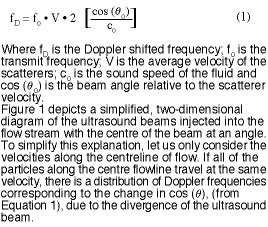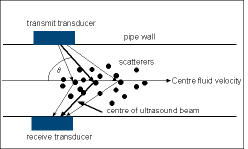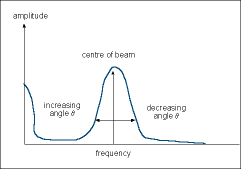

Clamp-on ultrasonic Doppler flowmeters are used in a wide variety of industrial, chemical, wastewater and food processing applications. Understanding how these nonintrusive flowmeters work will help you to understand when to use them.
Clamp-on ultrasonic Doppler flowmeters flow in full pipes containing slurries, sludges, emulsions, dispersions and pulps - any liquid containing suspended particles or droplets of a material with a sonic impedance that is different than the sonic impedance of the carrier liquid. To assess useful applications for Doppler flowmeters, it is necessary to understand the basic operating principle of the meter and some understanding of relevant ultrasound scattering theory.
Operating principles
Most Doppler flowmeters use separate transmit and receive transducers clamped onto opposite sides of a pipe exterior. An ultrasonic beam is transmitted through the pipe wall into the flowing fluid at an oblique angle to the flow. The intercept of the transmit and receiver ultrasound beams is directed at the centre of the flow. The receiver collects scattered ultrasound from a core group of flowing particles travelling down the central axis of the pipe. This received ultrasound is shifted in frequency from the transmitted ultrasound in accordance with the general Doppler equation:


The received Doppler shifted frequencies mix with the transmit frequency, resulting in a group of beat frequencies. These time domain, sinusoidal beat signals are digitised and converted to the frequency domain via a fast Fourier transform (FFT). The frequency spectrum generated by the FFT is scanned to find the dominant peak frequency. Figure 2 illustrates a typical frequency distribution from a Doppler flowmeter. The point of highest intensity, the frequency spectrum peak, indicates the centre flow velocity.

The centre flow velocity is then converted to average flow velocity using flow profile correction factors based on Reynolds number and pipe roughness. Profile corrections allow the meter to maintain accuracy when transferred from one pipe size and material to another. The average flow is determined by multiplying the internal cross-sectional area of the pipe by the average fluid velocity.
What constitutes a reasonable Doppler application?
Sonic scatterers
Doppler flowmeters are not generally promoted for use on clean fluids. While powerful Doppler flowmeters can read the minute particles in municipal drinking water on small pipes under laboratory conditions, Doppler flowmeters cannot read the flow of highly distilled water.
In real applications, strong Doppler shifted signals are required for reliable flow measurement. The amplitude of the Doppler shifted signals from any application is largely related to the suitability of the sonic scatterers in the flow for producing detectable Doppler signals.
Identifying suitable sonic scatterers for Doppler flowmeters is a complex combination of four basic criteria. How well the criteria are met determines the reliability and accuracy of a Doppler flow application. The four criteria are:
1. The scattering material must have a sonic impedance different from the fluid.
2. There must be some particles large enough to cause longitudinal scattering.
3. For a given pipe size, the longitudinal scattering must have sufficient energy to overcome the Rayleigh (energy wasting) scattering caused by smaller particles.
4. The scattering material must travel at the same velocity as the fluid for good accuracy.
The sonic impedance of a material is the product of the density and the sound speed. An ideal Doppler scatterer has the same density as the fluid, but a different sound speed. Polyethylene particles, for example, can be used in water for testing and calibration purposes. The polyethylene has a density nearly identical to water, and a sound speed one-third higher, so the overall impedance is one-third higher. While some impedance difference is required, the dominant characteristic defining useful scatterers is particle diameter. The 500 µm diameter of the polyethylene particles creates very strong longitudinal scattering, with a concentration of only 0,025% by volume. The similar density of the materials keeps the particles in a suspended slurry. To present useful guidelines, the following discussion will use water as the liquid carrier and 500 kHz as the transmission frequency (a common Doppler transmission frequency).
Particles less than 50 µm (0,002") fall in the Rayleigh regime, and only waste ultrasound energy by thermoelastic and viscoinertial scattering. High concentrations of particles in this range are extremely difficult to measure by any ultrasound method.
Particles greater than 0,002" and less than one-eighth of an inch, create longitudinal, thermoelastic and viscoinertial scattering. The longitudinal energy increases with the particle diameter to the fourth power (d4) in this regime. In a dispersed particle distribution, a few large particles contribute the scattering needed for reliable Doppler signals while the smaller particles waste ultrasound energy. Because the ultrasound energy must travel through this highly attenuating media, pipe diameter becomes an important variable. A particular particle distribution generating sufficient Doppler signals in a small pipe may not produce sufficient signals in a larger pipe.
Particles of diameter greater than one-eighth of an inch cause high energy geometric scattering. Clamp-on Doppler flowmeters easily measure flows carrying small concentrations of particles in this size range.
In real applications, there is often a distribution of particle sizes. Experience has shown that if the volume of particles greater than 100 µm are 25% of the overall particle volume, the system is adequate for a Doppler flowmeter on moderate size pipes (ie, 6"). For larger pipes, the distributions may require 50% or higher.
An example is a slurry of water and calcium sulphate particles used for industrial stack scrubbing. The concentration is 4% by volume, pumped through a 6" fibreglass pipe. Most of the particles by count are very small and dissipate a great deal of the ultrasonic energy transferred into the slurry. However, 35% of the particles by particle volume are 100 µm diameter and greater, as depicted in Figure 3.

The percent of large particles by volume provides sufficient longitudinal scattering to overcome the dissipation effects of the smaller particles. While this application had low signal strength and a wide frequency spectrum, a reasonable and stable flow measurement was achieved.
Doppler flowmeters measure particle velocity and are dependent on scattering material travelling at the same velocity as the fluid for accuracy. How will particle size and density affect accuracy? For pulps and sludges, the sonic scatterers tend to be fibrous material of density less than or equal to water in high concentration. These fibrous materials create large drag forces, causing them to follow the flow streams of the fluid at the same velocity despite flow disruptions.

© Technews Publishing (Pty) Ltd | All Rights Reserved